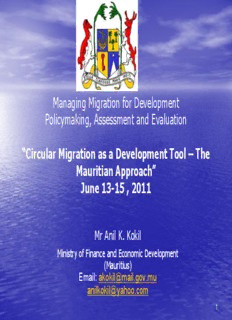
The Mauritian Approach. Anil K. Kokil, Ministry of Finance and PDF
Preview The Mauritian Approach. Anil K. Kokil, Ministry of Finance and
Managing Migration for Development Policymaking, Assessment and Evaluation “Circular Migration as a Development Tool – The Mauritian Approach” June 13-15 , 2011 Mr Anil K. Kokil Ministry of Finance and Economic Development (Mauritius) Email: [email protected] [email protected] 1 Location 2 Population • Mauritius has been described as the “land of migrants”. • It began to be settled as from the 15th century by people coming from different countries, namely India, Pakistan, Africa, China and Europe. • The Mauritian population is now constituted of European, African, Indian and Chinese. • Its population is now around 1.3 million. 3 Migration • After Independence in 1968, Mauritius witnessed a first wave of emigration to Europe, Canada, Australia, Italy and South Africa amongst others, mainly for political and economic reasons. • They form part of the Mauritian Diaspora estimated at around 250,000. 4 Key Economic Indicators • Population(2011): 1.3 Million • Investment (% of GDP) (2010): 24.8% • Languages: English, French and • Growth in Investment (2010): 3.4% Asian Languages • Budget deficit (2010): 3.2% • GDP growth: 4.4 % (2010) • FDI (2010): Rs 14 bn • Sectoral Growth rates (2011) – Health: Rs 2.7 bn – Financial Services: Rs 4.6 bn – Agriculture: 0.5% – Real Estate: Rs 3.4 bn – Manufacturing: 3.3% • Per Capita GNP – Tourism: 4.0% – Financial Services: 5.5% – 2010: US$ 7000 • Unemployment Rate (2010): 7.8% • Welfare State: – Male: 4.6% – Free Education (pre-primary to tertiary) – Female: 13.0% – Free Health Services • Literacy rate (UN - 2008): 88% – Free Social Security System • Inflation Rate (2010): 2.9% 5 Economy in brief • Before independence - 1968: Mauritius was a monocrop economy relying mainly on Sugar • After independence, Mauritius diversified its economic base – Setting up of EPZ (focusing mainly on Textile) and Tourism sectors • As from the 1990s: The Financial Services and ICT sectors emerged as new poles of growth. • From 2000 onwards, Mauritius broadened its economic base while strengthening further sectors such as ICT, Financial Services, Offshore and Freeport. • New poles of growth identified: Seafood hub, Aquaculture, Medical Hub, Integrated Resort Schemes, Pharmaceutical Hub, Knowledge Hub and Land Based Oceanic Industry, ICT – BPOs and Disaster Recovery Management. • Transforming Mauritius into a Duty-Free Paradise: 10 Duty-Free Shopping Malls under construction. 6 Challenges Challenges faced by Mauritius in the wake of globalization: dismantling of the Multi-Fibre Agreement in 2005 ( textile industry: moving from preferential trade to Global Competition) sharp cuts in the guaranteed sugar prices (-36 %) as from 2009 fluctuation in oil prices high rate of unemployment (increased from 6.7% in 2000 to 9.1% in 2006, female unemployment rate 15.5% in 2006) 7 Reform Programme – Government embarked on a 10-year Economic Reform Programme in 2005. – The Reform Programme focuses on the following 4 main planks: (a) Fiscal consolidation and Improved Public Sector efficiency (b) Improving trade competitiveness (c) Improving the Investment Climate (d) Democratising the economy 8 Mauritius‟ initiative to develop Circular Migration • As part of the reform programme and in order to widen the scope of opportunities for Mauritians, the Government took initiative to embark on Circular Migration – a short-term measure to address the unemployment situation in the country (Unemployment rate in 2006: 9.1%; female unemployment: 15.5 %). Unemployment 2006 - 2010 2006 2007 2008 2009 2010 Unemployment (%) Both Sexes 9.1 8.5 7.2 7.3 7.8 Male 5.5 5.3 4.1 4.4 4.6 Female 15.5 14.4 12.7 12.3 13.0 Source: Extract from Central Statistical Office 9 Circular Migration Since 2006, Government took the initiative to embark on Circular Migration. Objective 1: to widen the scope of opportunities for our citizens to take up employment abroad for a specific period, learn new skills, save part of their income, before returning to the country to set up a small and medium enterprise (SME) or invest in other economic activities; Objective 2: to encourage remittance flows and enhance their development impact; Objective 3: to harness the intellectual and financial resources of the Mauritian Diaspora. 10
Description: